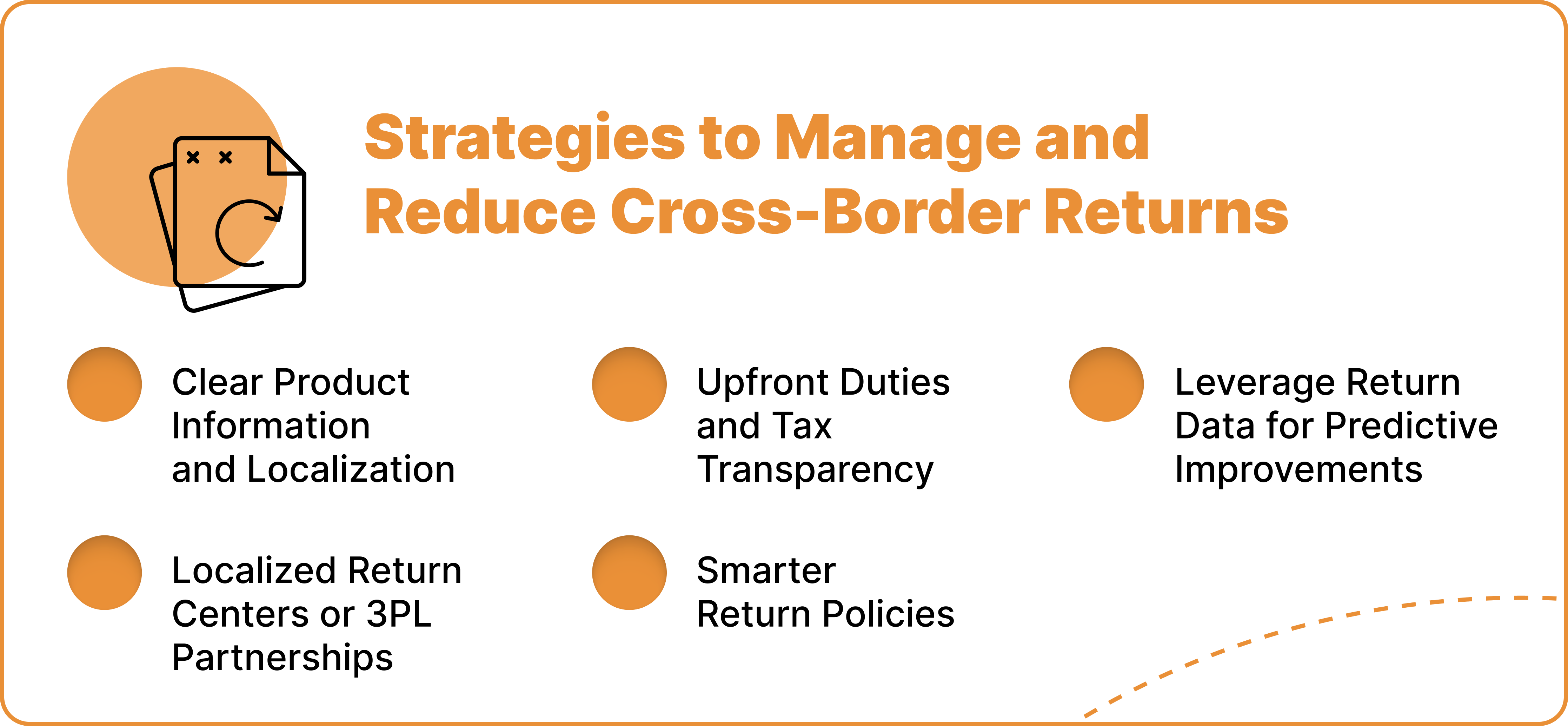The Hidden Cost of Cross-Border Returns on E-commerce Profitability

Many retailers celebrate reaching international customers. More orders, bigger markets, faster growth. However, few talk about what happens when those customers start sending items back. In a study by IMRG, e-commerce cross-border return rates averaged 25%, with apparel and footwear even higher.
The hit or impact of cross-border returns on the operating costs, profit margin, and bottom line is real. It can make or break your business, so properly navigating cross-border sales effectively is vital. One of the biggest misconceptions is that cross-border returns are just a shipping hassle. They are much more than that; they are a major profit leak. High overseas return rates can erase the gains made from selling internationally. Most brands treat returns like an afterthought, but the cost of overseas returns in cross-border trade needs a front-row seat.
This article breaks down the global returns impact, how it can drain margins, and what companies can do to improve their efforts in building smarter, more profitable international operations. It is not about selling more. It is about keeping more of what you sell.
The True Cost of Cross-Border Returns
At first glance, international orders look like big wins in value. A $100 order from Germany or Japan is celebrated. But when that order is returned, it may cost twice as much to bring it back.
Here is where the cost piles up:
- Customs and duties: Some fees are not refundable even for product returns.
- Loss and damage: The longer an item travels, the higher the chance it gets lost or broken.
- Transit times: Returns from overseas can take weeks. Meanwhile, the product cannot be resold.
- Warehouse processing: Returned products often need to go through inspection centers that specialize in international goods.
- Return shipping: International return shipping often costs more than the original delivery because, many times, the original delivery has the benefit of bulk pricing for the shipping.
All of this eats into the bottom line. For example, a $100 product that costs $10 to ship might now cost $30 or more to bring back and reprocess. If the item is damaged or seasonal, the economic loss grows even bigger.
Why Cross-Border Return Rates Are Higher
Not every return is about a bad product. Many cross-border returns happen because consumers find the buying process more complicated. An international return rate analysis shows that poor communication and misaligned expectations are the top reasons for higher returns. Here is how those two translate into returns.
- Sizing issues: Clothing and shoes are sized differently around the world. A US Medium Size is not a Japanese Medium Size.
- Unclear expectations: Product descriptions that work in one market might confuse buyers in another.
- Surprise charges: Unexpected customs fees on delivery can cause customers to reject or return items.
- Language barriers: Poor translation leads to misunderstandings about product features or policies.
- Hard returns process: If returning something is difficult or expensive, frustrated customers send products back faster without trying to solve the issue.
Impact Of Cross-Border Returns on Profitability
Each return hits the bottom line in more ways than one. Some are felt more than others, but ultimately, the business suffers. A Shopify report showed that every $1 million in cross-border sales without a strong returns plan could lose $150,000 to $200,000 due to return-related expenses. This loss is preventable if businesses build smarter processes from the start to estimate their returns correctly.
Here are some of the ways this happens:
- Labor cost spikes: International returns need more checks, paperwork, and coordination.
- Unsellable inventory: Items returned late, damaged, or out of season often cannot be resold.
- Customer service overload: Cross-border returns create longer support calls, emails, and refunds.
- Shipping and handling loss: Bringing the product back can cost more than the profit from the original sale.
Strategies to Manage and Reduce Cross-Border Returns

The best kind of returns are those that never happen. The more you can do to avoid returns, the better off your business will be. However, in the case of incoming returns, there are several proven strategies that can help you manage cross-border returns with greater efficiency.
1. Clear Product Information and Localization
Small mistakes cause big returns. To fix this:
- Include multiple photos from different angles.
- List material types, fit notes, and special instructions.
- Provide accurate sizing charts in local measurements.
- Use professional translation, not machine translation, for product listings.
When customers know what to expect, they order with more confidence.
2. Localized Return Centers or 3PL Partnerships
One of the biggest mistakes is forcing customers to send returns back to the home country.
Smarter move: set up regional hubs or work with a 3PL (third-party logistics provider) that can collect and sort returns locally.
Benefits include:
- Lower shipping costs
- Reduced customs paperwork
- Faster resale of returned products
Brands like ASOS and Zalando use regional return centers in Europe and North America to keep costs low and inventory moving.
3. Upfront Duties and Tax Transparency
Nothing triggers a return faster than surprise charges at the door. To avoid that:
- Be honest at checkout.
- Show full landed costs before the customer clicks buy, including product, shipping, taxes, and duties.
- Prioritize clear pricing because it reduces the chance of the customer rejecting the delivery or sending it back out of frustration.
4. Smarter Return Policies
Not every international sale needs to come with an easy refund promise. Do the following to protect your margins.
- Allow exchanges instead of returns.
- Offer store credit instead of cash refunds.
- Set shorter return windows (e.g., 14 days instead of 30).
- Require a return authorization before accepting items back.
Your cross-border returns policies should be fair but firm. Customers who know the rules upfront are less likely to abuse them.
5. Leverage Return Data for Predictive Improvements
Return data is a goldmine. Taking advantage can show you different customer behaviors across different markets and countries. However, before tracking, it is important to ensure you can analyze the right data. Start by tracking returns by: region, product type, and customer profile.
When you have these, then look for patterns such as:
- Are returns higher from a certain country?
- Does one style of jacket get returned more than others?
- Are return rates rising after a certain marketing campaign?
Use AI and predictive tools to adjust inventory, tweak product listings, or block risky transactions before they add losses. It puts you in a better position to make better decisions if done well. For example, adjusting sizing charts.
Managing Cross-Border Returns With ReverseLogix
Cross-border sales can drive massive growth. But without a smart plan for returns, they can just as easily wipe out profits. Understanding the global returns impact means looking beyond shipping costs. Your company must prepare for taxes, delays, losses, and unhappy customers.
At ReverseLogix, we understand the complexities involved in managing cross-border returns. Our comprehensive platform offers powerful tools to streamline cross-border return processes, ensure compliance with customs regulations, optimize duty and tax management, and simplify logistics.
By leveraging our expertise and innovative solutions, retailers can navigate the complexities of international returns, provide a seamless customer experience, and unlock the full potential of global e-commerce. Connect with us to know more about how we can benefit your company.

Frequently Asked Questions
Cross-border returns stretch the entire business. Shipping, customs, and customer service all get more complicated and expensive. Unlike local returns, international ones involve longer timelines, more paperwork, and a higher risk of loss or damage. Most retailers struggle because they rely on systems built for local markets, not digital channels that can handle overseas returns. Strengthening these operations is key to maintaining control over costs and customer loyalty.
Most companies collect return data, but few use it well. A better understanding of return reasons by product, region, or customer segment helps identify areas where small changes could reduce return rates. For example, if data shows that sizing issues are the biggest cause of returns in Europe, investing in better size guides for that market is smarter than cutting marketing budgets. Smart use of data sources leads to faster decision-making and smarter investments.
Returns are not just a logistics issue. They affect customer trust, brand image, and long-term profits. Brands that invest in better return policies and smarter reverse logistics see more repeat buyers and stronger international word-of-mouth. Managing returns well protects margins now while building sustainable growth for the future.
When companies identify opportunities to simplify returns or lower costs, they can act before problems grow. Quick wins like setting up a regional return can prevent bigger losses later. Comparison with competitors who delay action shows that proactive brands keep more profit and build stronger loyalty in digital channels.
Yes. Most retailers have spent heavily on outbound shipping and customer acquisition, but many still underinvest in return management. Investing in smarter returns tech, better communication tools, and regional logistics partners — supported by real data analysis — is essential. It is not just a cost center, it is an investment that protects e-commerce profitability, improves decision making, and drives better results across the entire business.
